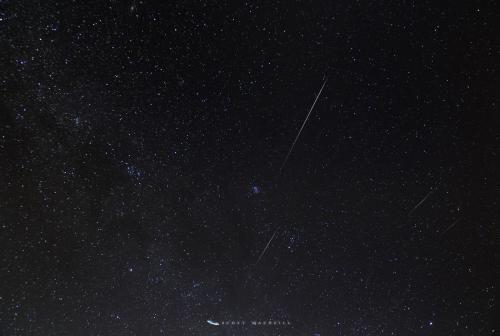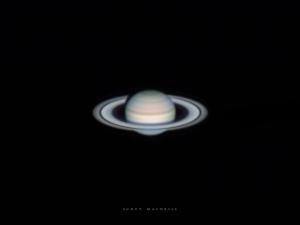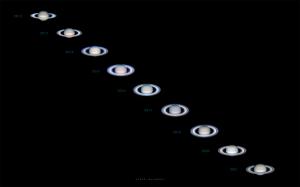Celebration of Space - August 19, 2022

The Geminid Meteor Shower at Frosty Drew Observatory. Credit: Frosty Drew Astronomy Team member Scott MacNeill
This past week a rather unexpected outburst of meteor activity occurred in the constellation Aquarius. The outburst is possibly a new meteor shower resulting from a comet that was discovered by Charles Messier (founder of the famous Messier Catalog of deep sky objects). The comet is named D/1770 L1 Lexell. Though the outburst was observed on August 15-16, meteors are still appearing, which indicates that the shower is ongoing, and may not have peaked yet. The initial designation of the potentially new meteor shower is M2022-Q1, though if confirmed it may be named the 18-Aquariid Meteor Shower. Being that the Moon is departing the night sky as it orbits towards its New phase on August 27, 2022, catching a view of this potential shower is quite opportune. The radiant point appears to be centered in the border between the constellations Aquarius and Capricorn, which places best viewing times for most of the nighttime period after astronomical twilight ends. If you’re up to trying for a view, set out to a dark location with a wide open view of the sky, and be there for 10:00 pm. Lay on your back with your feet oriented south and look to the Zenith (top of the sky). Who knows, you just may catch sight of several unexpected meteors from this outburst. As this event evolves, we will report anything that may be exciting!
On the James Webb Space Telescope (JWST) front, everything is fluffy kitty perfect! We’ve seen the first release images, which were mind-blowing, and then a surprise peak at Jupiter and its rings. Well now that JWST is fully operational, scientists on different projects around the world are starting to apply for time and are completing their science objectives using the new observatory. This past week, a group called the Cosmic Evolution Early Release Science Survey (CEERS) released a new panoramic image that they captured using the JWST, and the result is AMAZING! It is the largest image of galaxies yet captured by the JWST, and is only one third completed. The panoramic image itself is comprised of over 960 frames (fields of view), which were captured during June 2022. The second collection period will happen in December 2022. The target region that was imaged is a small section of the sky just off the end of the Big Dipper’s handle. Here is a low resolution image of the completed sections of the panoramic. Though if you want to have your mind fully toasted, download the full resolution version, Fair warning: be prepared to lose a good chunk of your day!
Now that Saturn has passed opposition, which is when Earth arrives at the point in its orbit where Saturn is on the opposite side of Earth than the Sun, Saturn is rising before sunset and getting earlier each night. This places Saturn’s visibility during our Stargazing Nights event times, eventually becoming visible as the first object on our list for the night. In 2022, the seasoned Saturn observer will notice that the rings have receded quite significantly this year, and are offering a much slender view than they have for the past 8 years. This happens due to Saturn’s orbital period, axial tilt, and Earth’s orbital period.
Saturn will take 29.5 years to complete one full orbit around the Sun. Saturn is also tilted 26.7° on its axis, and the rings are situated over Saturn’s equator. As Saturn continues its orbit around the Sun, its tilt remains the same, though the orientation of that tilt will appear to change if viewing Saturn from the vantage point of the Sun. In April 2003, Saturn reached its Winter Solstice, which would have placed the rings at 26.7° tilted away from the Sun. In May 2017 Saturn reached its Summer Solstice, placing the rings at 26.7° tilted towards the Sun. In May 2025, Saturn will reach its Autumnal Equinox, which will place Saturn’s rings neither tilted towards or away from the Sun. With this in mind, our view of Saturn will change each year as we catch up to the much slower orbiting gas giant. Our best views of Saturn happen when we are in between the Sun and Saturn, which means that our viewpoint would be the same as the Sun’s vantage point. In 2017 we observed the top of Saturn’s rings at maximum 26.7° tilt towards us. Since then that tilt has appeared to move towards the Autumnal Equinox, which is placing Saturn’s rings closer to an on-edge view. Saturn still looks amazing in the telescope, but the rings are noticeably thinner than they have been for the past several years. For a view of this, check out this project we have been working on at Frosty Drew Observatory to catalog the tilt orientation changes on Saturn since the year 2012. Now make plans to visit Frosty Drew Observatory this autumn and see Saturn’s rings for yourself!
Fantastic evening passes of China’s Space Station (Tiangong) continue this week over the US. Unlike the International Space Station (ISS), Tiangong is not continuously inhabited and periodically will house residents from China’s National Space Administration (CNSA). Tiangong is also modular, with only the first module currently residing in space. Over the next several years, China will attach two additional modules to the Tiangong station. Even though only one module is currently in orbit, the view is quite bright and easily noticeable when passing over. Here are a few fantastic opportunities this week to catch a view of Tiangong passing over the Northeast:
Fri, Aug 19 at 9:03 pm, starting in the W, rising to 89°, heading towards the E, and into orbital sunset ← Awesome pass!
Sat, Aug 20 at 8:02 pm, starting in the WSW, rising to 77°, heading towards the E ← Awesome pass!
Sat, Aug 20 at 9:39 om, starting in the W, rising to 51°, and into orbital sunset
Sun, Aug 21 at 8:39 pm, starting in the W, rising to 85°, heading towards the E, and into orbital sunset ← Awesome pass!
Mon, Aug 22 at 9:15 pm, starting in the W, rising to 72°, and into orbital sunset ← Awesome pass!
Tue, Aug 23 at 8:15pm, starting in the W, rising to 88°, heading towards the E, and into orbital sunset ← Awesome pass!
Wed, Aug 24 at 8:51 pm, starting in the W, rising to 51°, heading towards the SE, and into orbital sunset
Thu, Aug 25 at 9:28 pm, starting in the W, rising to 20°, and into orbital sunset
That list has several awesome passes listed, and this is certainly the week to get out for a view of Tiangong! It goes without saying that clearer sky conditions are needed to catch a view, but even patchy cloud cover will work out as you can see the station in between clouds. So put these dates on your calendar and set your alarms, because these are amazing opportunities to catch a view of a space based residency passing over. Note that these times are for Southern New England, but will be generally acceptable for the entire Northeast.
- Author:
- Scott MacNeill
- Entry Date:
- Aug 19, 2022
- Published Under:
- Scott MacNeill's Columns




